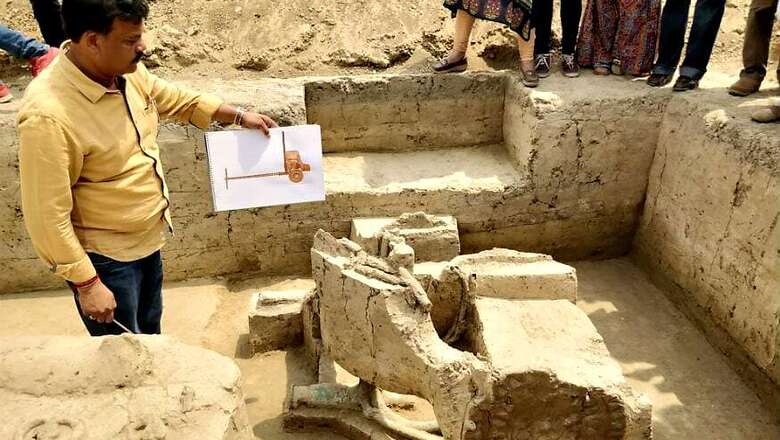
views
Baghpat: For the first time in the Indian sub-continent, burial pits have been found with chariots that date back to the Pre-Iron Age(Bronze). This new finding is set to create space for further investigation on dating of the Mahabharata period and further inquiry into the origins of the horse in the Harappa age, as per the experts involved in the three-month trial dig Uttar Pradesh's Sanauli.
The excavations that the team of archaeologists conducted was unveiled on Monday showing burial pits with chariots in the Pre-Iron Age (Bronze).
The burial pits have been found in the past excavations at Rakhigarhi, Kalibangan, and at Lothal, but the chariot has figured for the first time.
The excavation started in March 2018 at Sanauli and was conducted by a 10-member team with SK Manjul, of Institute of Archaeology, established in 1985, heading it. The co-director was Arvin Manjul.
Speaking on the development, Manjul said, “We have the place in the ancient global history. To name a few of our contemporary cultures, chariot appears in Mesopotamia, Georgia, Greek civilisations, and with this finding we can say that among our contemporary cultures in the Pre-Iron Age we too had chariots.”
He added, “This is giving our history and our past a new dimension – we have to rethink our past and approach it with a fresh perspective – with the elements found in the burial pits it shows we were a warrior clan in the Pre Iron Age.”
Who rode the chariot in the Bronze Age?
If there was a chariot in the Bronze Age, would it not need a beast to run it? Was it a bull or a horse? Manjul said, “This is debatable, it could be a bull or a horse but having said that the preliminary understanding points at the horse. The chariot is a lookalike of the ones found in its contemporary cultures like Mesopotamia, it is a solid wheel with no spokes.”
The chariot is with solid wheel and pole; in one of the pits the excavators have also found crown or helmet worn by the rider of the chariot.
Chariots figure prominently in the Rigveda, which gives evidence of their presence in India in the 2nd millennium BCE. Among Rigvedic deities, notably Ushas (the dawn) rides in a chariot, as well as Agni in his function as a messenger between gods and men).
Manjul added that in the past there has been evidence of horse in the Chalcolithic period. This discovery is an added thrust to inquire further into ancient Indian history.
If we go by the world history, there is evidence of wheeled vehicles only from the mid-4th millennium BCE in Mesopotamia, the Northern Caucasus (Maykop culture Bronze Age) and Central Europe. The question concerning which culture originally invented the wheeled vehicle remains unresolved.
The objective of the research
In 2005, excavations around 116 graves belonging to Indus Valley Civilisation were found. These graves, dated 2200–1800 BC were a fairly recent addition to the list of Indus Valley Civilisation sites in India.
The archaeological experts wanted to take the research and investigation in that region further and conducted excavations just 120 meters away from the earlier site, as a trail dig, and found chariot in the excavation. They dug eight burials and each tells a different story of the life and style prevalent in Pre Iron Age period. These decomposed wooden coffins were decorated with copper but with time have turned green due to patina.
“The challenges were many – we had to dig in a way that the structure standing tall does not get damaged in further deeper digging. This is the first time we used the X-Ray, CT scan to find the nails embedded in the wooden coffins,” added Manjul.
There are eight burial pits – which have skeletons, beads, pottery, chariot, sword, torch. These are wooden decomposed coffins with copper decorations that made the spotting of the coffin easier. There are eight anthromorphic figures having horned and peepal leafed crown decorated on cover of coffin. The designs are aesthetic and say a lot about the society in Pre-Iron Age.
“This throws light on the lifestyle and cultures of the people who lived in the Pre Iron Age – there are mirrors with copper, the elaborate burials, all this shows the society was technologically advanced, aesthetic and had the sense of art and craft. They were warrior clans, and had a sophisticated lifestyle,” added Manjul. The evidence found here is important to conduct further investigation in finding “horse skeletons”.
In one of the burials, one can find the dog being buried; in Hindu mythology, dog is the vehicle of Yama. There are symbolic burials with just objects buried without a body, maybe in reverence of the deceased not found and twin burials showing two skeletons in one grave.
Counterview
The horse driven chariots are known in the Vedic period, said historian DN Jha. “However, iron makes appearance in the post Vedic or not earlier than the late Vedic period. This find cannot be dated to the pre-Vedic/Harappa phase,” said Jha.
Several scholars have written on the dating of the Mahabharata, but Jha said that he is not aware of who has used the evidence of chariots for dating the text of Mahabharat.
Some archaeologists like B B Lal have argued for the 8th century BC, on the basis of the silt deposited at Hastinapur, which was flooded following the Great War. “But this hardly inspires confidence. In fact the text is so full of interpolations that it cannot belong to one point of time,” said Jha
According to V S Sukthankar, whose work on the chronology of the text is authoritative, Mahabharata’s composition spreads over several centuries. “The general consensus is that the text was composed over a period of about a millennium - roughly between 400BC to 400AD. However, there are some scholars who argue for a shorter period. In any case the Mahabharata in its present form cannot be the work of single author and that is one of the reasons which make its dating difficult,” Jha added.















Comments
0 comment